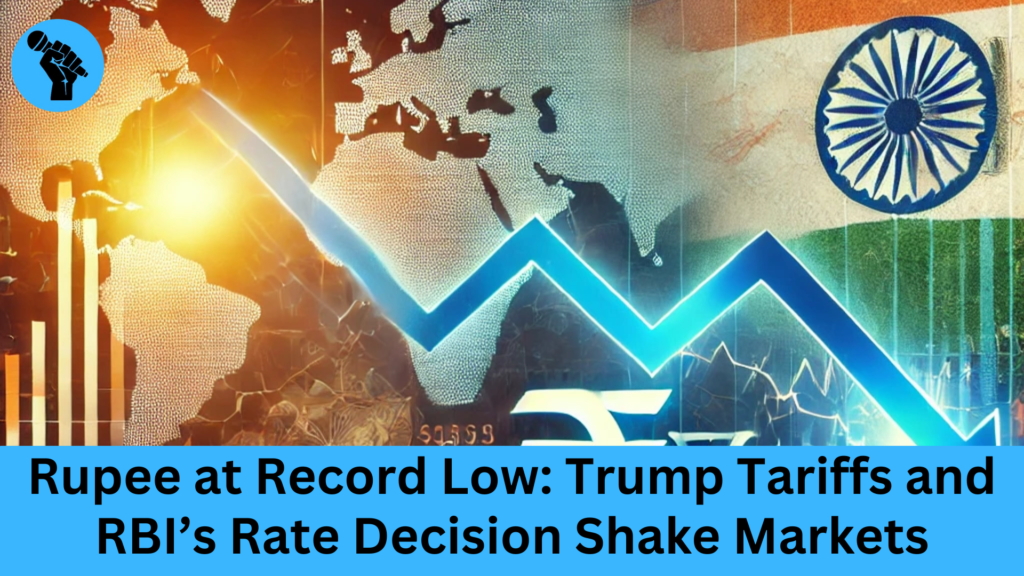
Rupee at Record Low: The Indian rupee has emerged as the worst-performing Asian currency this year, hurt by a combination of global trade tensions and domestic uncertainties. The rupee hit an all-time low of 87.43 against the US dollar on Wednesday, against the backdrop of President Donald Trump’s controversial tariffs on imports from Mexico, Canada and China. This is a dangerous sign as the Indian currency has registered a massive devaluation, to the extent that some reports indicate a depreciation of 20% in five years and more alarmingly, by 5% in two years.
Rupee at Record Low:
The main reason for the rupee’s weakening is the aggressive trade war, which has increased investors’ risk aversion. Trump has imposed a 25% tariff on goods imported from Mexico and Canada and a 10% duty on Chinese imports, which is causing a stir in the global market. China retaliated by suggesting tariffs on US goods, further adding to the uncertainty factor.
Experts believe that emerging market currencies, especially the rupee, will continue to face the weight of tariffs as risk sentiment still remains weak. The ongoing tariff war has already fuelled fears over the long-term nature of trade instability, which has adversely impacted the rupee’s performance. Despite sporadic dollar selling by state-controlled banks, the RBI has kept its intervention to a minimum to prevent direct interference in rupee pricing and keep the rupee in sync with the trends of other currencies.
Jatin Trivedi is VP Research Analyst at LKP Securities. He said that due to these fears of the ongoing tariff war between the US and China, emerging market currencies have weakened, and the Indian rupee in particular fell by Rs 0.35 to 87.40. According to Trivedi, although the dollar index has come down from 108 in the last few days, the rupee continues to hold its weakness due to continued FII withdrawals and persistent trade uncertainties.
Looking ahead, Trivedi predicted that the rupee could weaken further towards 87.75, and any potential decline may face resistance around the 87.15 level. As the situation unfolds, market participants will continue to monitor developments in the trade war and their impact on global market sentiment.
Moody’s rating agency also expressed similar apprehensions, saying the Indian rupee is one of the weakest performing currencies in South and South-East Asia. In the case of Indian companies such as Bharat Petroleum Corporation, Hindustan Petroleum Corporation, Indian Oil Corporation and Bharti Airtel that have managed to mitigate the impact of the strong dollar, the larger implication of a fall in the rupee remains a big challenge.
The Indian economy is also dealing with other domestic pressures due to high expectations of RBI interest rate cuts. The RBI’s monetary policy committee began a three-day session on February 5, while market analysts predicted a 25 basis point reduction in the benchmark policy rate. This will be the first rate cut in five years, aimed at supporting the economy, which is grappling with slow growth and inflation within the central bank’s comfort zone.
Anuj Chowdhary, research analyst at Mirae Asset Sharekhan, said global trade tensions as well as apprehensions over the possibility of a rate cut are going to keep the rupee under pressure. According to him, as long as uncertainty over tariffs persists, the rupee will remain weak. Besides, traders will also keep an eye on the release of US economic data such as non-farm employment and ISM Services PMI.
On the global front, Brent crude prices also declined. Brent crude prices fell 0.51% to $75.81 per barrel in futures trade and investor sentiment further soured.
While the rupee is facing downward pressure, there is some hope that the RBI will take decisive action to provide some relief to the markets in its policy meeting. However, the combined impact of global trade disruptions and domestic economic factors suggests that the road ahead for the rupee remains challenging.
Domestically, the benchmark BSE Sensex closed 0.40% lower at 78,271.28, while the Nifty fell 0.18% to 23,696.30. Once again, FIIs continued their selling spree, selling shares worth ₹1,682.83 crore.
India’s macroeconomic growth in services did not look very impressive, at least on the statistical front, where the HSBC India Services PMI Business Activity Index fell to 56.5 in January from 59.3 in December. This reflects the slowest pace of growth in more than two years.
Thus, the rupee will remain in the doldrums and people are waiting for the RBI’s monetary policy announcement on February 7. This decision may provide some clarity on which direction the central bank is headed in managing the economy amid global uncertainty and turmoil. This could be a key determinant of the currency’s future direction.
